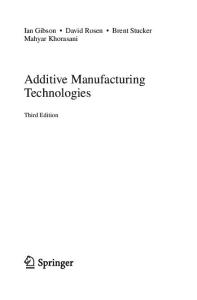Materials and manufacturing renaissance: Additive manufacturing of high-entropy alloys
- PDF / 1,434,080 Bytes
- 21 Pages / 584.957 x 782.986 pts Page_size
- 48 Downloads / 1,035 Views
Materials and manufacturing renaissance: Additive manufacturing of high-entropy alloys Jinyeon Kim, Akane Wakai, Atieh Moridia) Sibley School of Mechanical and Aerospace Engineering, Cornell University, Ithaca, New York 14850, USA a) Address all correspondence to this author. e-mail: [email protected] Received: 17 February 2020; accepted: 15 May 2020
The disruptive potential of additive manufacturing (AM) relies on its ability to make customized products with considerable weight savings through geometries that are difficult or impossible to produce by conventional methods. Despite its versatility, applications of AM have been restricted due to the formation of columnar grains, resulting in solidification defects and anisotropy in properties. To achieve fine equiaxed grains in AM, alloy design and solidification conditions have been optimized in various alloy systems. In this review paper, the microstructure of high-entropy alloy (HEA) parts produced by selective laser melting and powder-based directed energy deposition is investigated. Solidification maps based on laser process parameters (as opposed to most commonly used solidification velocity and temperature gradient) are constructed by compiling available literature for single-phase face-centered cubic, body-centered cubic, and multiphase HEAs. These maps could guide printing of HEAs and provide an insight into the design of novel HEAs for AM.
INTRODUCTION High-entropy alloys Generally, the properties of metallic materials are improved by adding a low fraction of alloying elements. For instance, the content of manganese and carbon is altered in steel to change the deformation mechanism and improve mechanical properties [1]. Thus, the numerous alloy systems have been explored near the edge of the phase diagram [marked by the blue area in Fig. 1(a)]. However, using this approach, the compositional space of conventional alloys is searched in a restricted manner based on the belief that alloy design toward the center region of the phase diagram favors the formation of an intermetallic/ intermediate compound rather than a solid solution. However, after it was discovered that adding multiple alloying elements in similar quantities allows for the formation of a single solid solution [2], the opportunity to develop new alloy systems has been extended. These newly developed alloys that consist of more than five elements with similar atomic fractions are called high-entropy alloys (HEAs) [2, 3, 4, 5, 6, 7, 8, 9, 10, 11]. Instead of the term HEAs, other terminologies are sometimes used to expand the definition of these alloy systems beyond singlephase solid solutions or restriction on the configurational entropy, e.g., multi-principal element alloys and compositionally or complex concentrated alloys [11].
© Materials Research Society 2020
The thermodynamics of phase stability is used to describe the formation of the solid solution in HEAs [2]. When the number of alloying elements increases, the contribution of configurational entropy exceeds the enthalpic one, and as
Data Loading...











